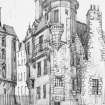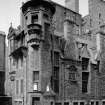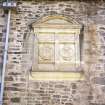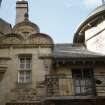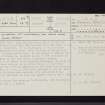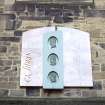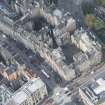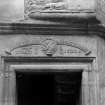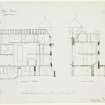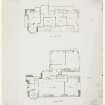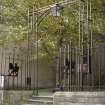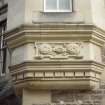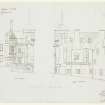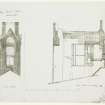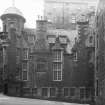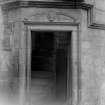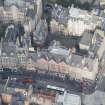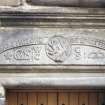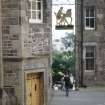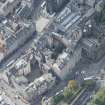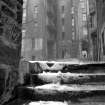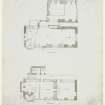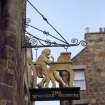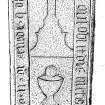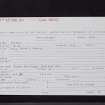Edinburgh, Lawnmarket, Lady Stair's Close, Lady Stair's House
House (17th Century), Museum (20th Century)
Site Name Edinburgh, Lawnmarket, Lady Stair's Close, Lady Stair's House
Classification House (17th Century), Museum (20th Century)
Alternative Name(s) Lady Gray's House; 10 North Bank Street
Canmore ID 52529
Site Number NT27SE 64
NGR NT 25550 73603
Datum OSGB36 - NGR
Permalink http://canmore.org.uk/site/52529
- Council Edinburgh, City Of
- Parish Edinburgh (Edinburgh, City Of)
- Former Region Lothian
- Former District City Of Edinburgh
- Former County Midlothian
NT27SE 64 25550 73603
(NT 2555 7360) Lady Stair's House, built in 1622 was originally called Lady Gray's House after the widow of the first proprietor. It was purchased in 1719 by their granddaughter Elizabeth, first Countess of Stair, with whom it became identified. It was bought in 1895 by the Earl of Roseberry, restored by him in 1897 and given to the City in 1907 for use as a municipal museum. Built of rubble with freestone dressings, the house is of 3 main storeys and an attic, oblong on plan from either end of which extensions of 1700 have been removed, as well as a wing of 1725 which extended on the W. When these additions were removed, both gables had to be rebuilt, and there is also much modern work on the W side.
RCAHMS 1951; T B Whitson 1910.
No change from previous field report. The building is now in use as a museum.
Visited by OS (S F S) 26 November 1975.
ARCHITECT: George Shaw Aitken (restoration) 1897
Original house 1622
REFERENCE: NATIONAL LIBRARY OF SCOTLAND
Vol II, No 10, "Water Colour Sketches"-Series by Thomas Brown, Advocate Reference-"Adv. MSS.34.8.1-3" -1 view
(Undated) information in NMRS.
Publication Account (1951)
(17) A 15th-century grave-slab probably from the churchyard of Holyrood, complete but for the upper edge. It now measures 5 feet in length and tapers from 1 ft. 5 in. in width at the top to 1 ft. 2 1/2 in. at the bottom. It bears a floriated cross with a foiled base, incised above a chalice and paten. Around the margin run two heavily contracted inscriptions in Gothic lettering, there being two persons commemorated. The first, unfortunately incomplete at the beginning and towards the end, reads ... CANON[ICVS] S(AN)C(T)E + QUI OBIIT DIE ME(N)SIS . [...A D M} CCCCC. ('Here lies ... Canon of the monastery of Holyrood who died on the ... day of the month of .... in the years of the Lord 1500'). The second inscription runs HIC IACET D(OMPNVS) V(ILLELMVS or ALTERVS) LAMB FR(ATER) OR(DINIS) EIVSDE(M) Q(VI) OBIIT IX D(IE) D(ICTI) M[ENSIS} ('Here lies Sir William (or Walter) Lamb, brother of the same order, who died on the 9th day of the said month').
At the time of the RCAHMS visit, this was held amongst a collection of carved stones in Lady Stair's House.
RCAHMS 1951, No. 15 (17)
Publication Account (1951)
15. Lady Stair's House, 477 Lawnmarket.
Originally called Lady Gray's House, after the widow of the original proprietor, Sir William Gray of Pittendrum, this 17th-century property was purchased in 1719 by their grand-daughter, Elizabeth, first Countess of Stair, with whom the house and the close of which it formed the W. side thereafter became identified. Threatened by a clearance scheme in 1893, it was bought in 1895 by the fifth Earl of Rosebery, a later descendant of Sir William Gray’s, in order that its preservation should be ensured. Having renovated the building, Lord Rosebery presented it to the City in 1907 for use as a municipal museum. To fit it for this purpose extensive structural alterations were required, both internal and external, so that to-day the domestic arrangements no longer obvious. But the available facts have been gathered together by Sir Thomas B. Whitson, of whose account in the Book of the Old Edinburgh Club, iii (1910), pp. 243-52, free use has been made in the present article.
Built of rubble with freestone dressings, the house has three main storeys with an attic above, the lowest floor accommodating itself to the falling site. On plan it has an oblong main block running N. and S., from either end of which additions of 1700 have been removed, as well as a wing of 1725 which extended on the W. into James' Court over a narrow passage called Gladstone's Close. The major division has a newel-stair tower projecting from the S.E. corner, its superstructure an innovation more elaborate and less functional than the original termination. The lower part is original and is set out on an attractively moulded encorbellment above the entrance. The doorway has a moulded architrave. On the lintel is a central cartouche, parted per pale and charged: Dexter, a lion rampant, for Gray of Pittendrum; sinister, a saltire, with a crescent for difference, representing Smith of Grothill. Behind the cartouche runs a label inscribed FEARE THE LORD & DEPART FROM EVILL. The initials W G and G S for Sir William Gray and Geile (Geida or Egidia) Smith, his wife, appear on either side of the coat of arms and are repeated in monogram on the left, balanced by the date 1622 on the right, between amulet at one end of the lintel and a cinquefoil at the other.
When the additions were removed from either end of the main block, both gables had to be rebuilt, and there is much modern work in the W. side also ;but something of the original character is left in the E. elevation although the eight windows on the lowest floor, the architectural framework half-way up the wall, and the top window at the N.E. corner date only from the restoration. The wall-head bears two heavy chimney-stalks, the more northerly one incorporating a pediment surmounting an original window, which balances a pediment attached to the stair-tower. A third pediment, in the centre stands free. Both the two long, transomed windows below the central pediment as well as the southernmost one were originally two windows, at first and second floor levels respectively.
When the house was put up for sale in 1825 the internal accommodation was described as follows:" The sunk storey consists of a good Kitchen, Servants' Closets and Cellar. The second storey of a Dining and Bedroom, and the third of a Dining Room and five Bedrooms." The principal access to the upper floors was the newel-stair, but there was also a straight stair between the first and second floors within a slight projection, on corbelling, to the W. The doorway at the head of this stair survives but the stair itself has been in part renewed. Probably the only other early feature in situ is the large fireplace on the first floor. This has a modern hood, but the elaborately moulded jambs, which rise from bell-shaped bases to capitals of much the same form, are of a type common in the more important houses of the late 16th and early 17th century.
RCAHMS 1951, visited c.1941
[the original text includes a description of 23 architectural fragments]






























